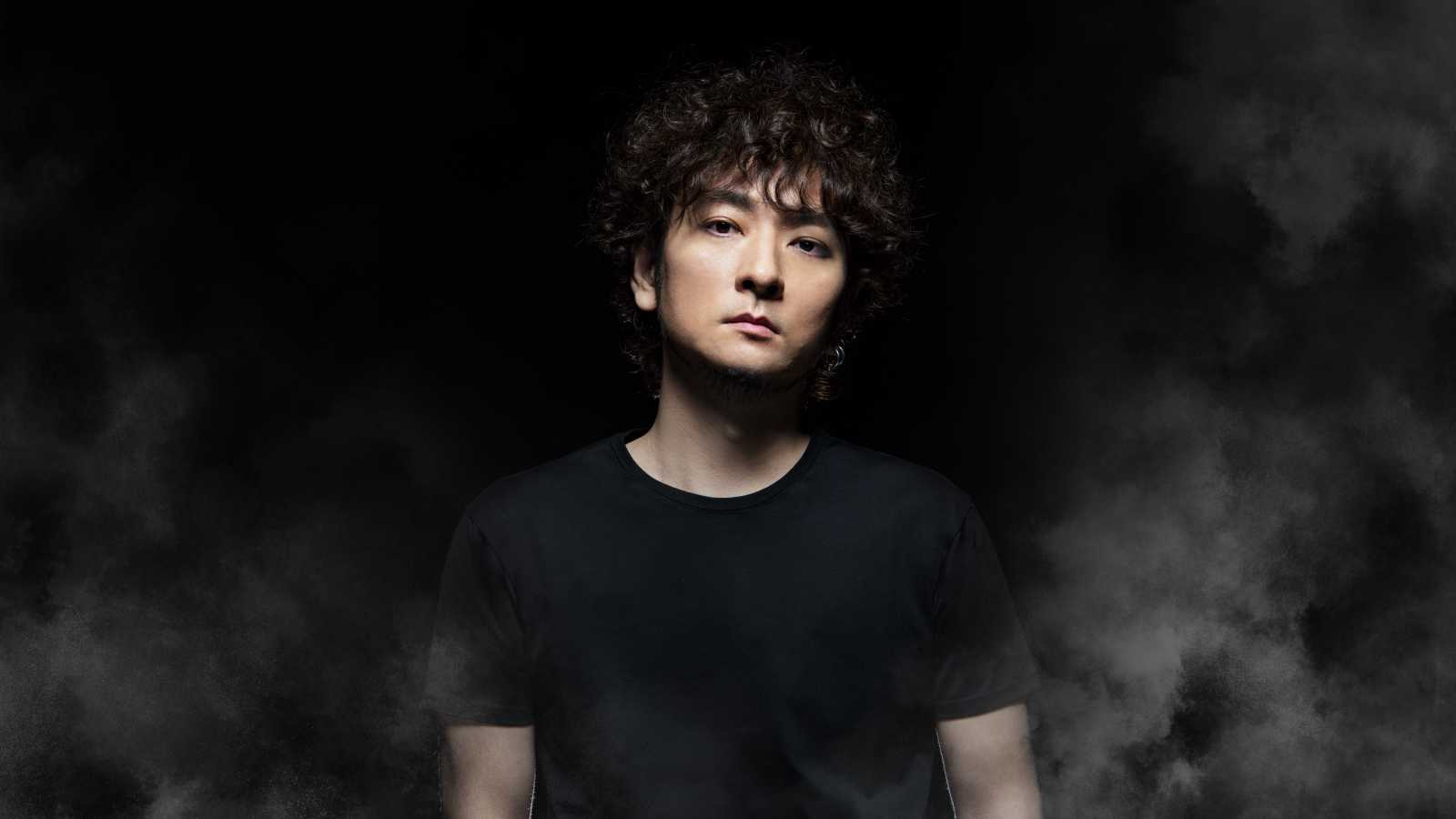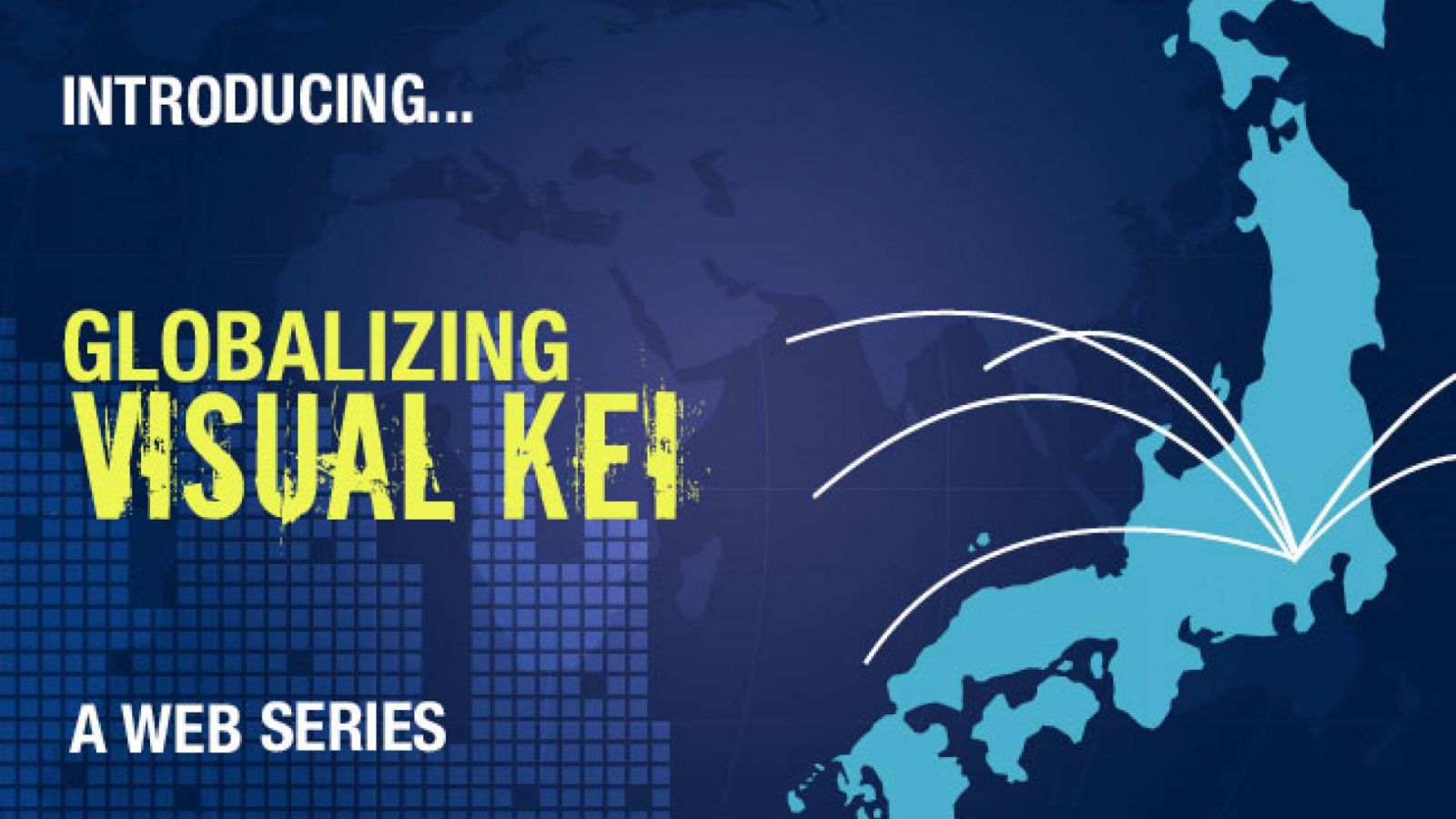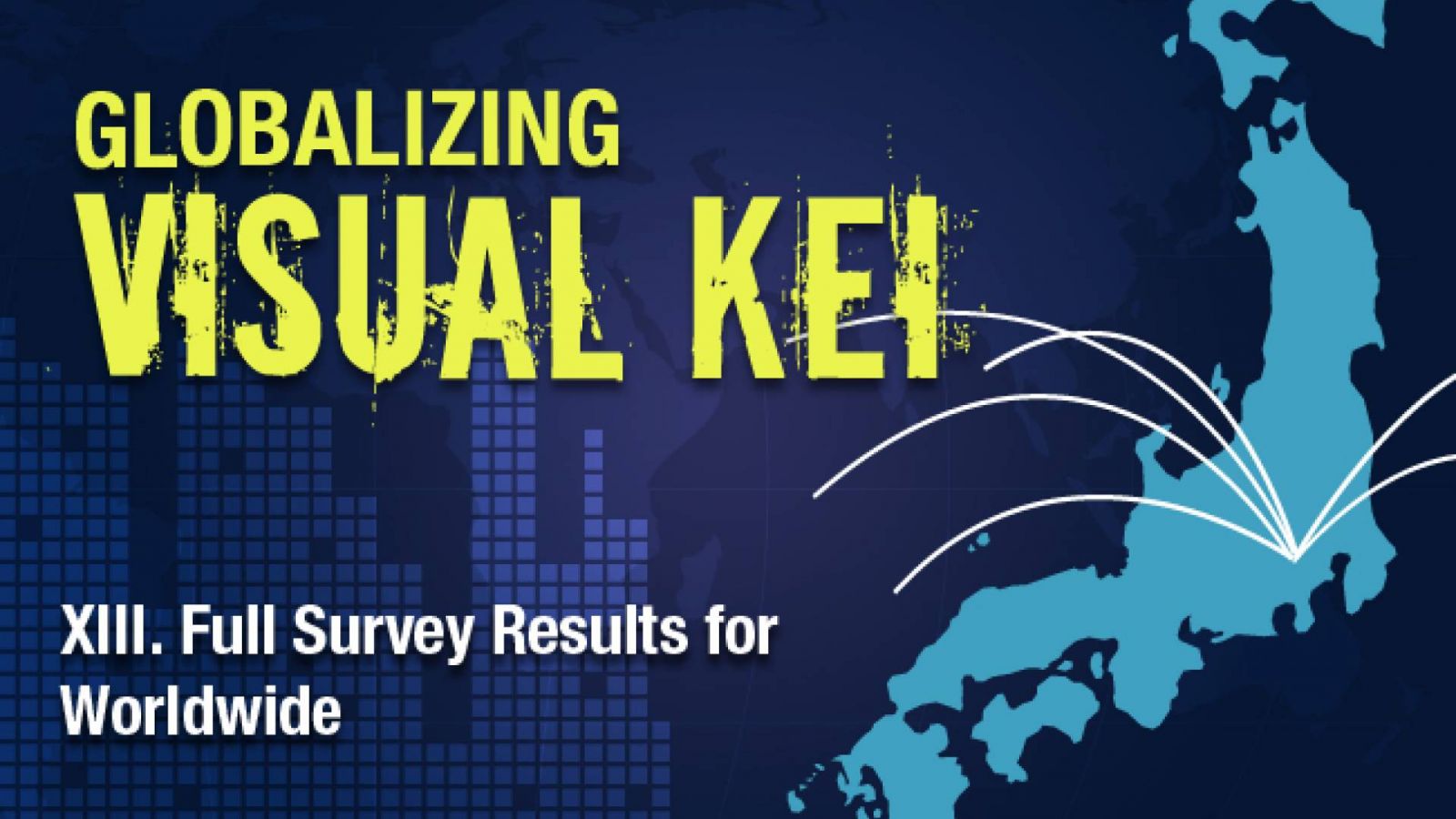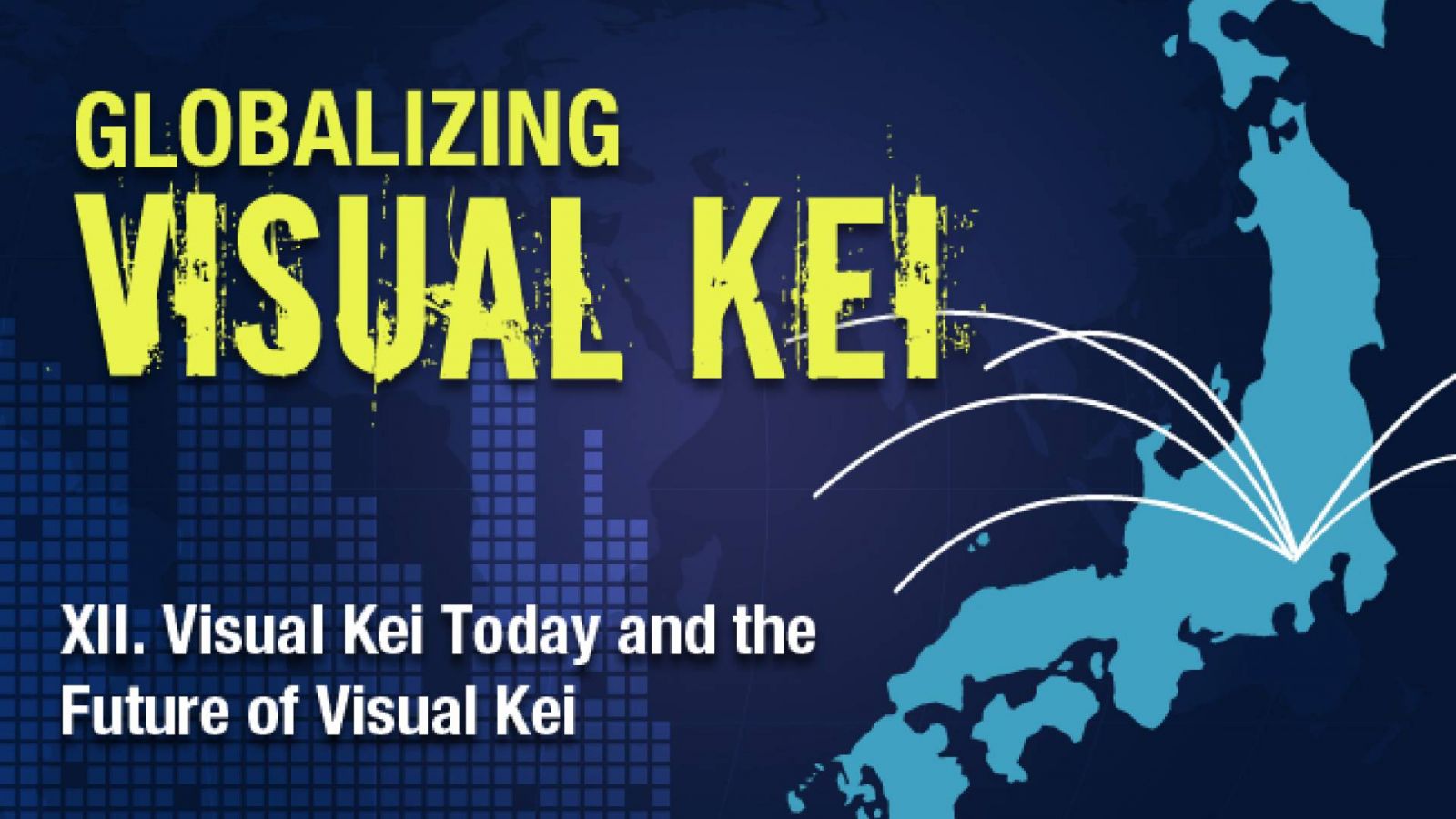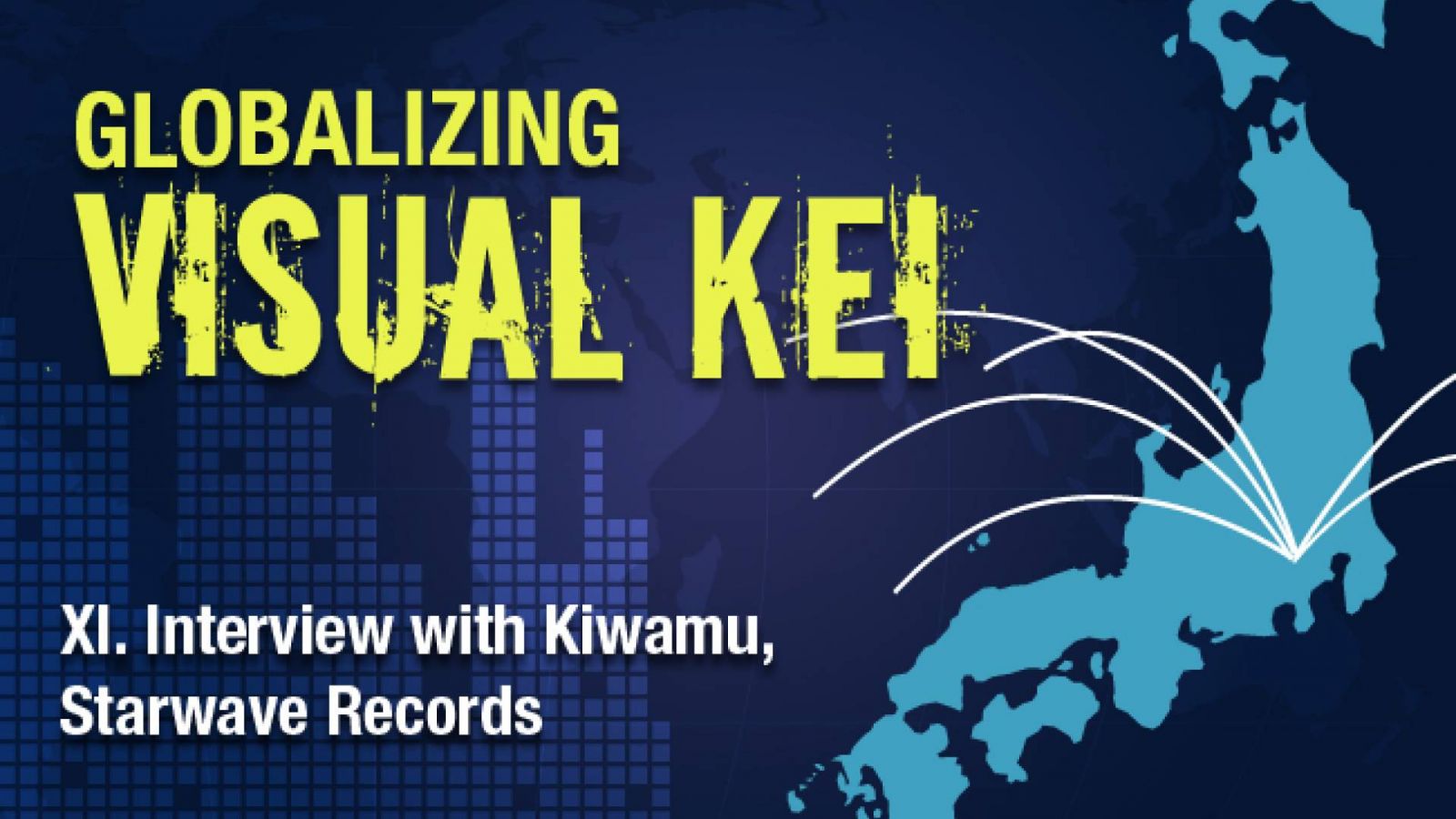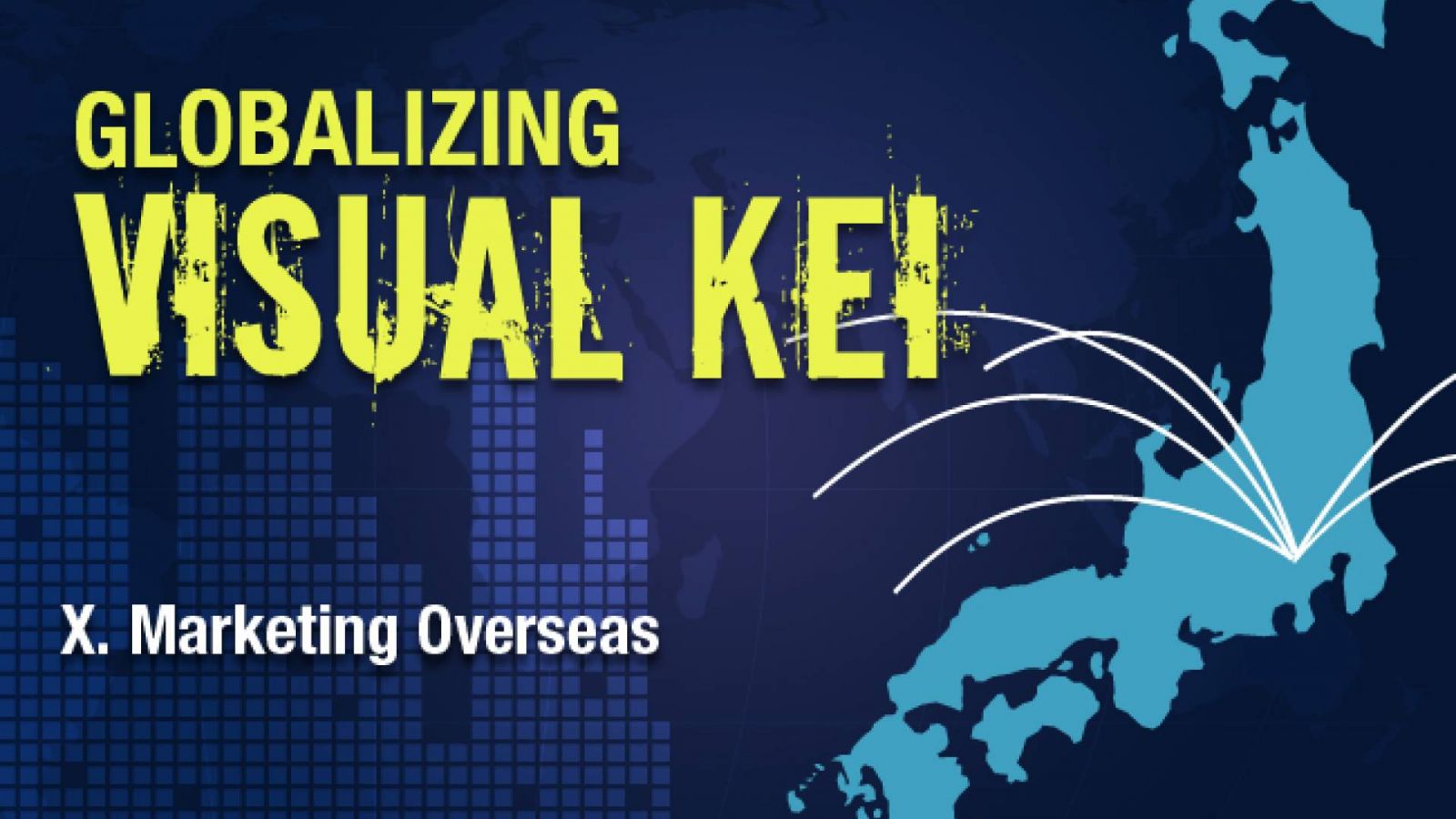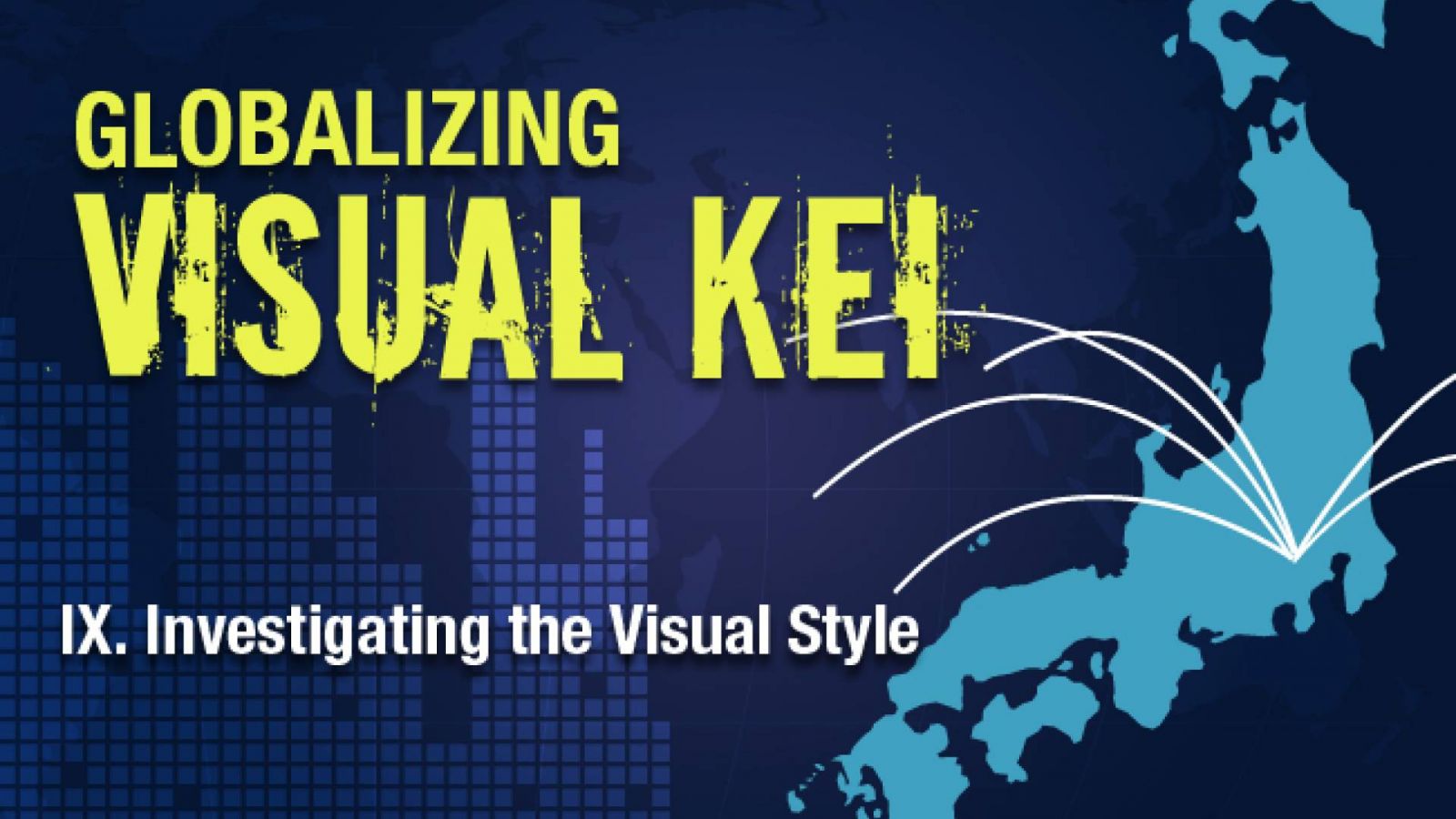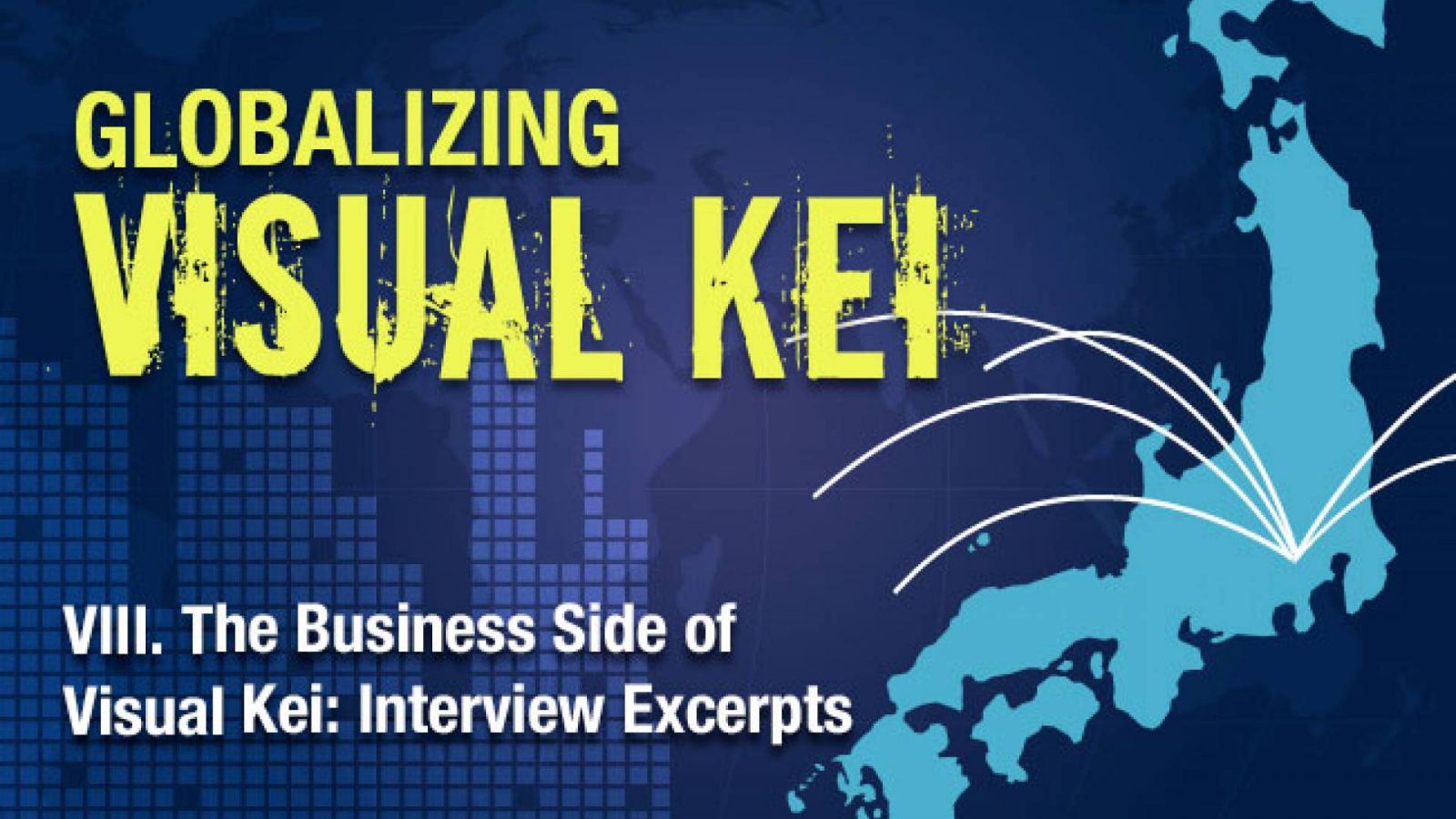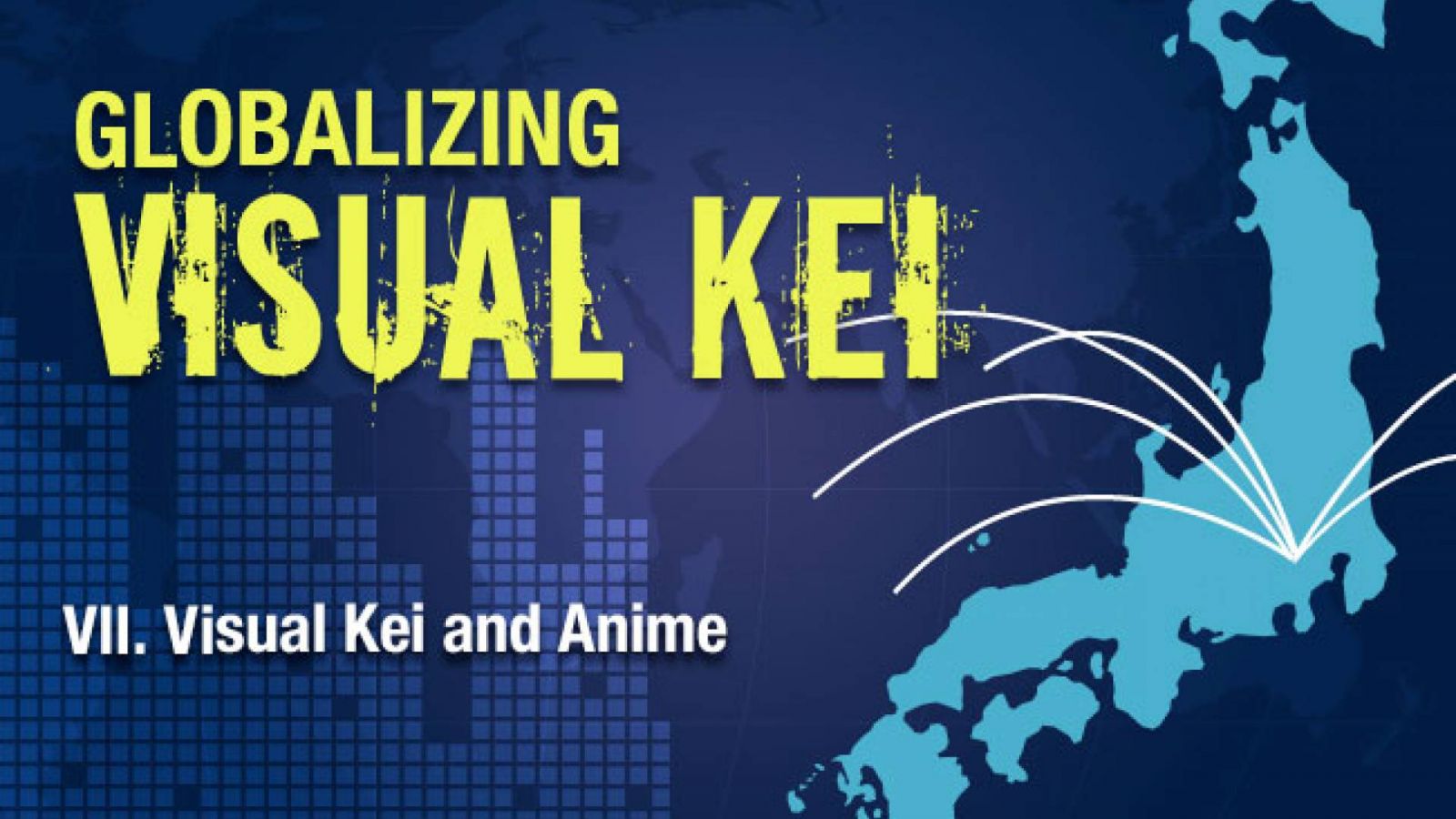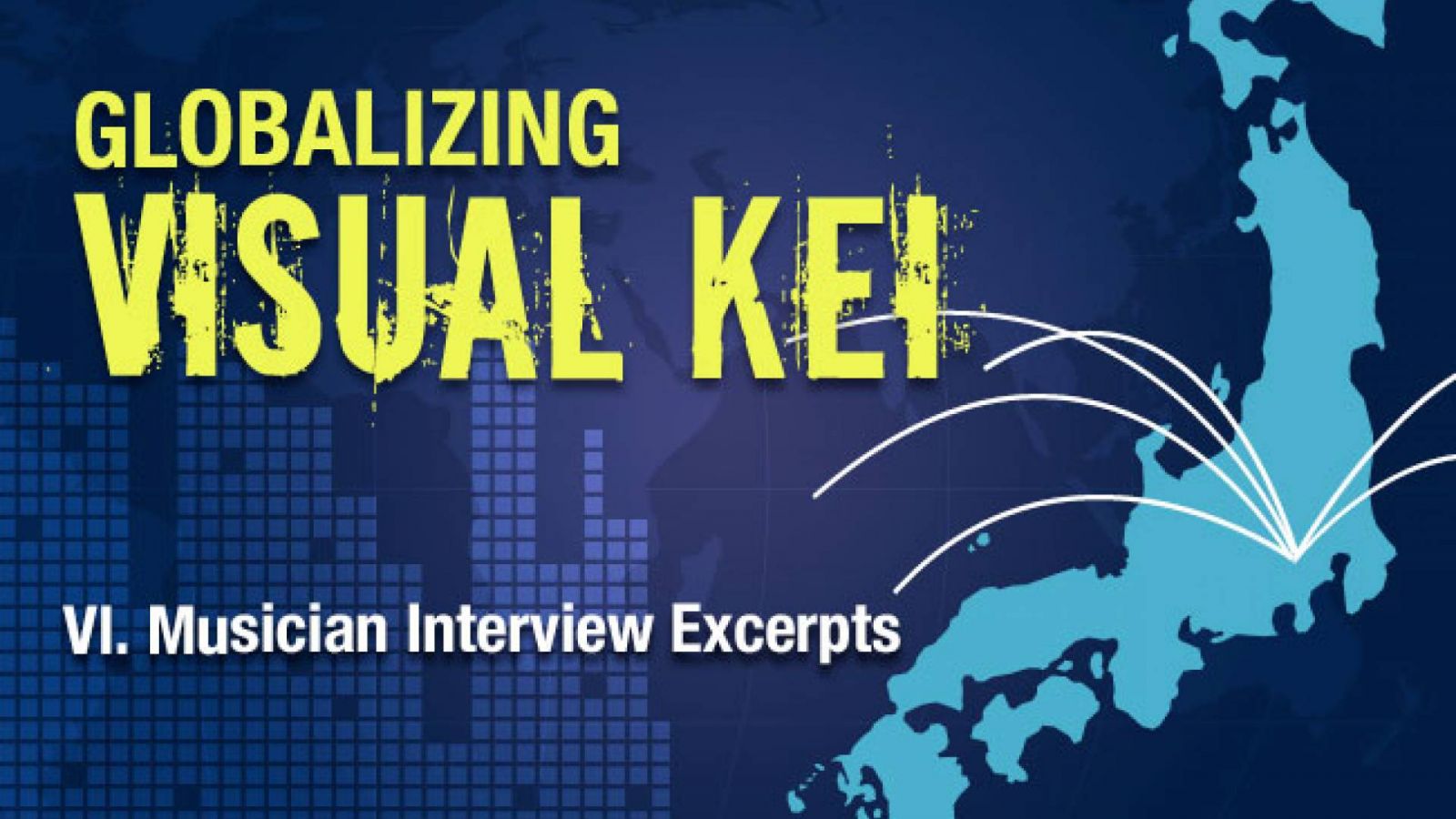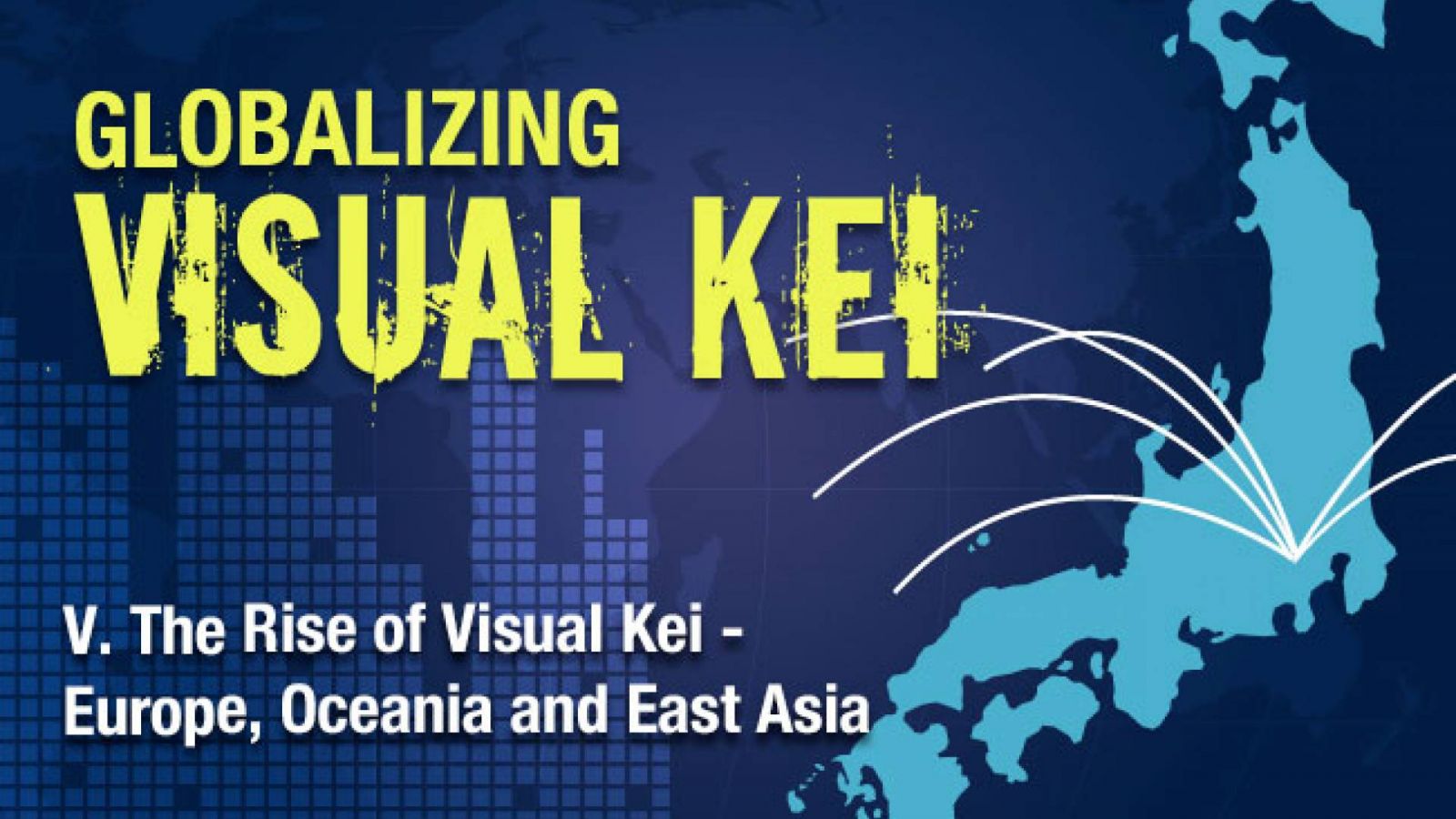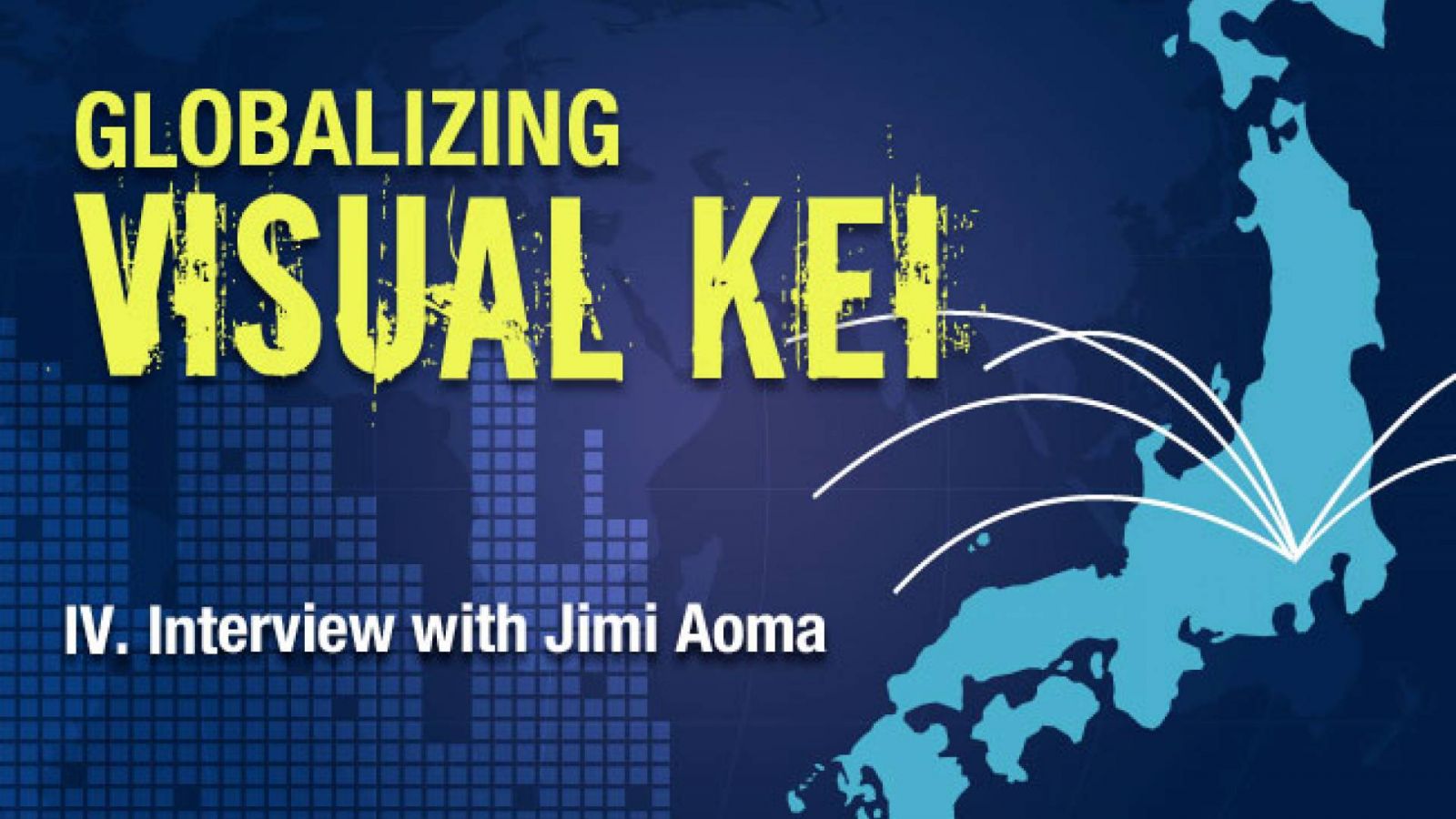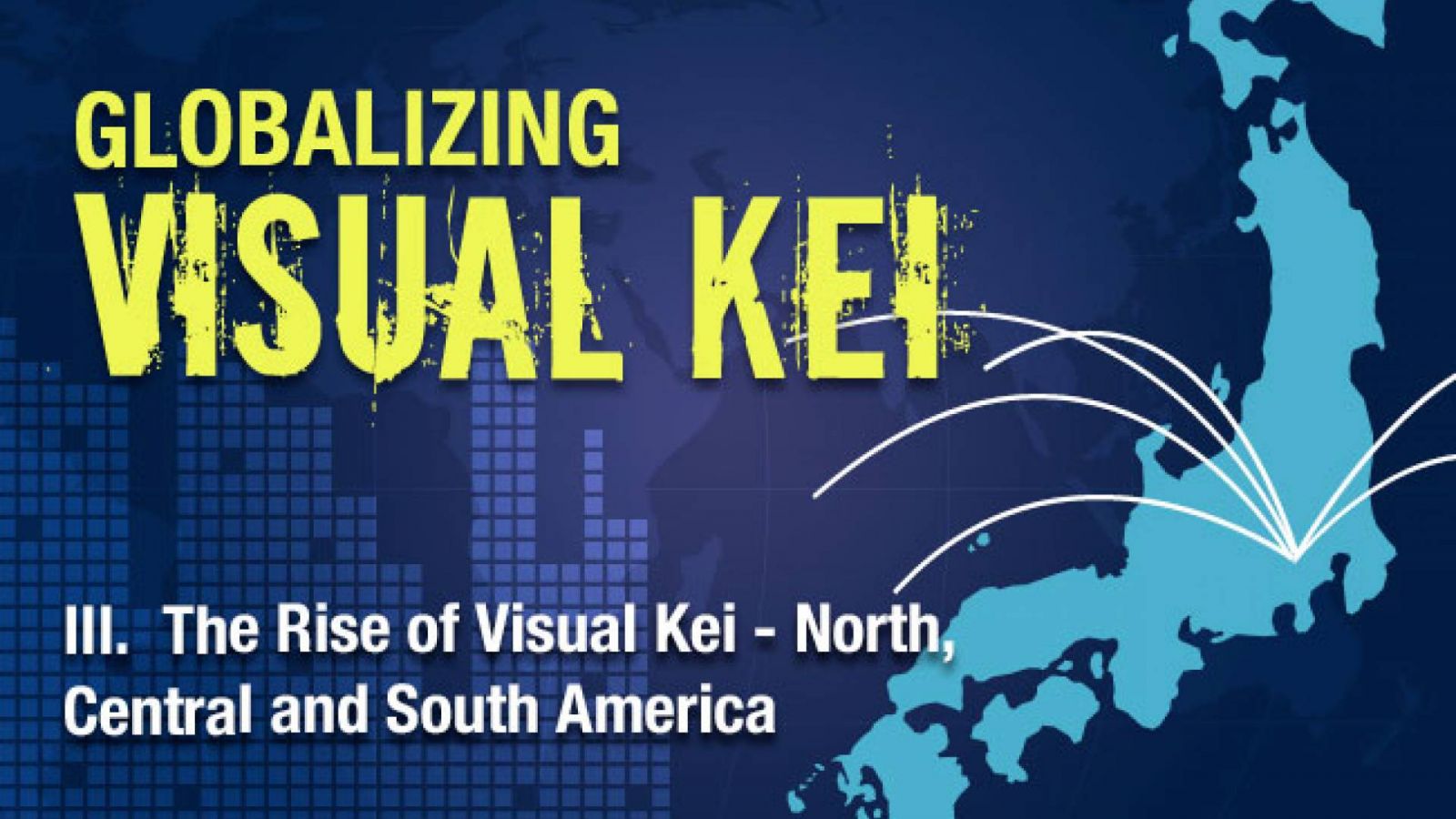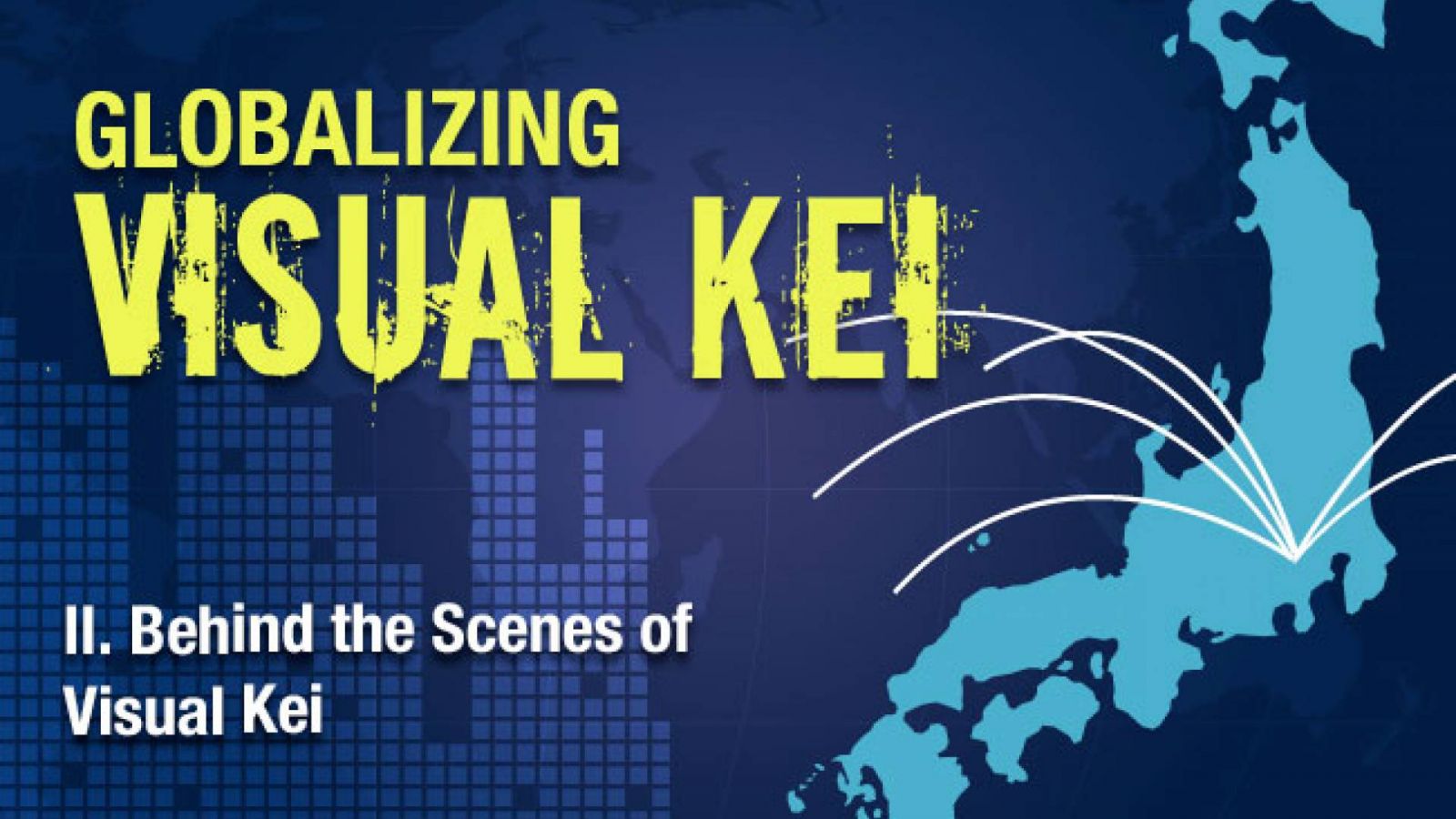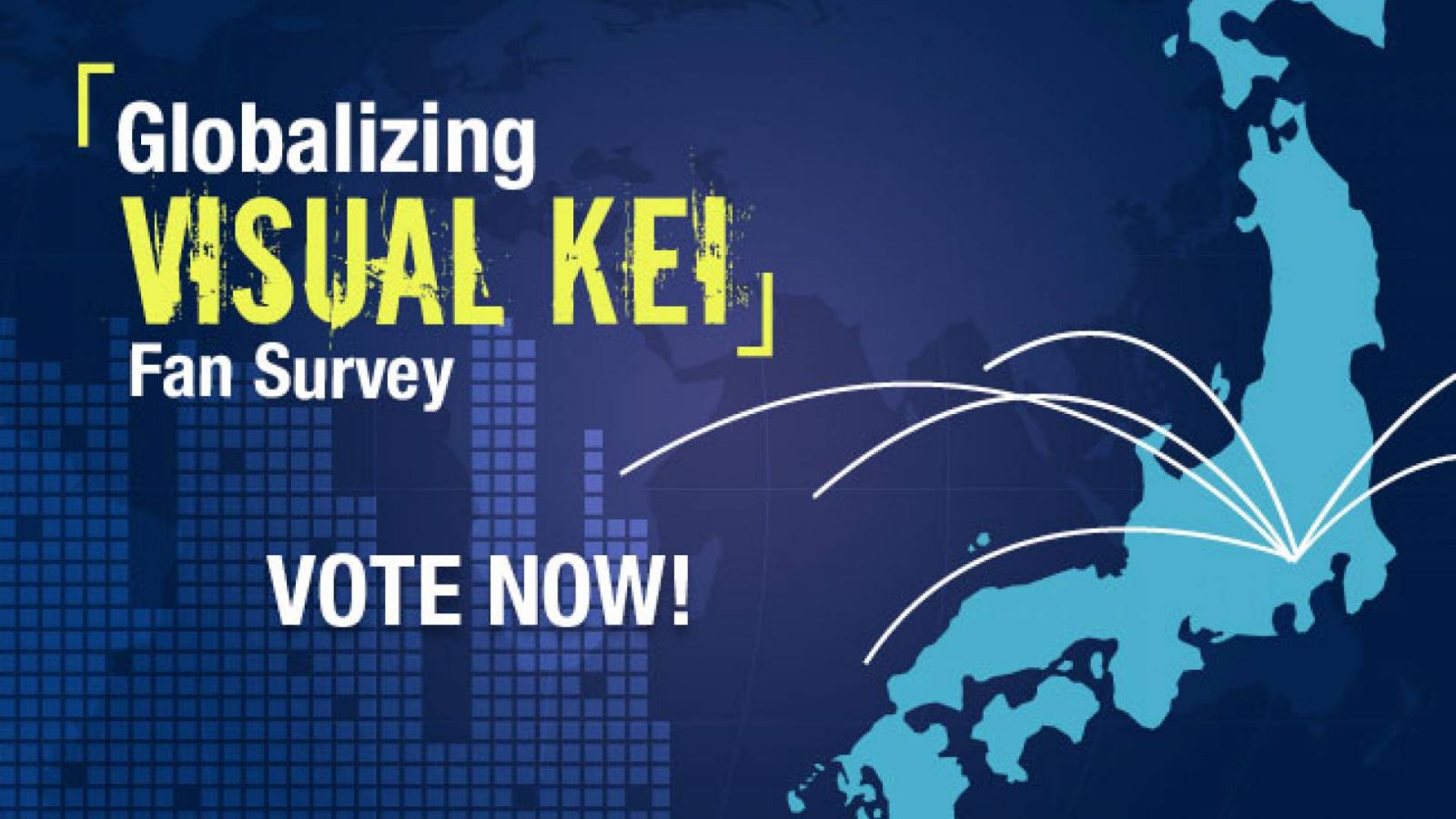In the eighth installment of the "Globalizing Visual Kei" web series, JaME interviewed a number of press and industry personnel from promoters to magazines to learn more about the business side of visual kei.
During my research for this web-series, I worked with many different organizations ranging from anime conventions to magazines and promoters around the world to try and provide a well-rounded view of the visual kei scene. These are excerpts from the interviews which were conducted.
Anime NEXT
Anime NEXT is an anime convention based out of New Jersey. Starting in 2002, they have been steadily growing in size and enjoyed an attendance of over 8,000 guests in 2010. Frequently a host of Japanese visual kei bands, Anime NEXT graciously granted our interview to let us know how this world works from their point of view.
How is the attendance rate for visual kei events at Anime NEXT? Has there been any fluctuation over the years?
Anime NEXT: Our attendance rate for all our bands is very positive, although with visual kei you get a slightly different vibe to the audience.
How does Anime NEXT decide what visual kei bands it would like to have as guests?
Anime NEXT: Anime NEXT never tries to get pigeon-holed with just one type of band. We are constantly trying to find that next big thing- be it visual kei or any other scene, we just try to bring our attendees the best band we can.
Who is primarily responsible for funding the trip and expenses for the band?
Anime NEXT: We are primarily responsible.
In the eyes of Anime NEXT, how does visual kei fit into the spirit of anime and the convention scene?
Anime NEXT: Many of our attendees are already big fans of the various aspects of Japanese culture and are already fans of the visual kei scene; whereas other attendees love learning new aspects of Japanese culture. By bringing in a visual kei band we can diversify our offerings and expose people to new aspects of Japanese culture
Finally, is there anything else you would like to share with us?
Anime NEXT: Yes of course. Let all your fans know that our hearts and best wishes go to the people of Japan at this time, and we consider ourselves blessed by the band and guests that we have coming here from there. Oh yeah, if you're in the area, June 10-12 in Somerset NJ, come see the show*. It's the NEXT GENERATION of anime convention
Author's Note: This year’s guest at Anime NEXT was the visual kei artist Mix Speaker's,Inc.
_______________________________________________________________
Cameron Scholes
For western fans who were into visual kei at the start of the millennium, Cameron Scholes was a name known by many. Owner of the website “Glam Japan” and the now-defunct visual kei magazine “BLUSH,” Cameron helped to push visual kei overseas by not only engaging with fans online but also exporting hard-to-get merchandise to fans via eBay and other selling avenues.
You were a pioneer for foreign fans of visual kei in the early millennium years. Can you describe what the visual kei fan scene was like at that time?
Cameron: In 2000, there were virtually no foreigners on the scene aside from Jennifer who owned the website “Bonjour Honey.” She was really only into a select few bands, unlike myself that played the entire field and was interested in any band that wore lipstick. At the time, the internet was in its infancy and band websites didn't exist. There were publications of course, the long standing SHOXX and the short lived V-Shot, as well as numerous pro-zine style publications, but all done in Japanese. The only thing about the scene that really changed in those eight years was the influx and interest by foreign fans. The whole philosophy of visual kei in Japan has remained the same.
Can you tell me about BLUSH magazine? Why did you decide to do it? Was it easy to get interviews and live reports?
Cameron: With the visual kei indies scene in 2000, I fell upon something fantastic. The second I began going to lives, I knew immediately that there would be an interest for this scene outside Japan. But it was 2000. I had a website, the only one outside of "Bonjour Honey", and that attracted a lot of attention. But I felt that there was (of course) so much more I could do. I went to Draculina Publishing, a small outfit in the States that published pro-zines. It was an easy in for me as I had already been putting out a successful pro-zine through them for years, so when I proposed the idea of BLUSH it wasn't too hard to get a green-light on the first issue. I got a few interviews, but I didn't consider them to be important at the time as nothing that band members would say would have much relevance to a foreigner outside Japan; a foreigner who didn't know the scene, the system, the clubs, not to mention the members specifically. I choose instead to do articles about bands, concert reviews, and CD/demo tape reviews because that allowed me to get as many different band names/pictures onto the pages as possible. That was information vital to introducing the scene, and getting foreigners up-to-speed ASAP with what was happening on the scene at the time.
How well did BLUSH magazine do? Why did you ultimately pull the plug and not re-try the idea years later?
Cameron: BLUSH did very poorly. So poorly that Draculina Publishing pulled the plug on the second issue. And as much as I wanted to disagree with the publisher, he was very right about one thing. He said, “Music, especially indies, doesn't have the same sustainable power with music fans as say, genre films has with film fans,” and he was right. If a visual kei fan was to come across my fanzine today, they probably wouldn't buy it because the bands, the CDs, the demo tapes, and the concert reviews are outdated and irrelevant to the scene currently. Music and bands often lose their relevance with time; films not so much. Horror fans still cite 70’s films like “The Texas Chain Saw Massacre” as one of their favorites, despite the plethora of gorier, newer titles on the market since then. Film buffs hang out to their history, much more so than do music fans. I mean, how many 80’s hair bands are still topical these days, get their albums re-released, and sell millions of copies?
In the years that followed BLUSH, more and more foreigners came onto the indies scene in Japan and in turn spawned more visual kei websites and message boards. By then, doing something like that seemed like conquered ground for me. So I let the “new fans” carry the torch while I moved on to greener visual kei pastures; and I do mean greener. And that green was eBay. There was no money in putting out a pro-zine or fanzine, but there was great money, sacks of it, in selling visual kei on eBay. Nobody else was doing it at the time. CD Japan never existed, Closet Child wasn't around, and visual kei bands didn't sell overseas at all. It was perfect. The very definition of virgin territory and I popped the cherry. And by doing so I could still spread visual kei, meet lots of new fans and friends, and at the same time fill my pockets with great gopping wads of cash. It was an insane time, right up until I left Japan in December 2008. And I think I did more for visual kei by selling on eBay than I ever could have done with a magazine. I literally brought music to the people; not just words and pictures. That sounds terribly pretentious, but I'm being honest.
Alas...the party is over, for all of it. Visual kei on eBay died in or around late 2009, downloading has replaced the expensive overseas "mail order" CD route (and eBay), and the plethora of blogs and websites have turned fanzines into 8-track tapes. The reality is, visual kei was never going to be big enough to support the kind of promotional empire that fans were building around it.
Nathan Reaven of Hear Japan wrote an open note to fans essentially saying that downloading was “killing visual kei bands' chances of ever becoming popular overseas.” Do you agree with that or do you think there is more to it?
Cameron: Of course I agree, but downloading is an inevitable evil because of the audience visual kei attracts in the current state of techno-logic advancement of the Internet. First, we're not talking a fan base with disposable income. We're generally talking teens and people in their early twenties. These are people with a finite amount of money, yet the visual kei scene is flooded with new bands at every turn, who in turn flood the scene with maxi CDs, mini albums, A & B style releases, DVDs, special editions, live-only stuff, etc.
If you expect obsessive visual kei fans just to sit back and “play fair,” you're bloody dreaming. Visual kei fans will continue to bleed the scene for as long as they can because that is the only way they can keep up with all the music. And if the scene on a foreign level dies because of it, then they will all just shrug their shoulders and say... “Shit. It was cool while it lasted.” That's just human nature, and no “open note to the fans” is going to be met with any sort of capitulation. It's a noble, but ultimately pointless and feeble gesture by someone who should have a better grasp on reality and human nature.
Why do you think there's such a fluctuation of fans within this scene?
Cameron: Being a foreign visual kei fan is tantamount to having an internet girlfriend or boyfriend. How long is that relationship going to last past the initial infatuation? For those fans living in Japan, visual kei is the greatest scene to be involved in. It's in your face 24/7 and if you let it, it will become your lifestyle. It's that big and involving. But outside Japan, fans are limited to what they can do and how deep they can be involved. They can't go to awesome CD shops and browse through tons of stuff, can't go to cool lives any day of the week, can't do band meet and greets, can't get cool promo stuff, can't have Japanese visual kei friends, and most importantly (or sadly) they can't “live” the scene like Japanese fans do. Foreign fans are mostly relegated to watching the scene evolve from their computers. So you have these visual kei newbies that just tire of sitting in front of their computer screen and figure, forget it, this is crazy. All this stuff is happening in Japan, and I can't be actively involved. Then a lack of interest sets in and eventually they bail on the whole scene. Most foreign visual kei fans are window shoppers. Never able to set foot in the store. That has to wear on you after a while.
Why do you think visual kei is still a sub-culture despite having become a globalized music style? Do you think there is any way to bring it above-ground?
Cameron: Visual kei has two factors that will forever keep it from the mainstream in a global sense: the lack of English usage, and the heavy use of gender-bending make-up and fashion. Putting aside the opinions of visual kei fans, to the average rock music listener (the big global market out there) visual kei bands dress as girls and appear gay. Whether that is true or not is irrelevant. Those are the first reactions from average rock music fans, 99% of which will be utterly turned off by that glamour element regardless of how interesting the music is. So if the average rock fans around the world can't get by the make-up and fashion element, which they generally will not, then it's over; dead in the water! And that is exactly why visual kei is in the state that it is today. For over a decade I've tried to introduce visual kei to countless friends and associates who are into rock and metal, and the result is generally the same. The glamour and “androgynous performing” turns them right off, no matter how cool and heavy the music is. I've even tried playing the music first to get them hooked. But it never fails...when I then show them the imagery, they recoil in an exclamation of "WTF???" And that's when the CD comes out of the car stereo.
_______________________________________________________________
Kokaku Music
Kohaku Music is a growing promotional group which has been bringing visual kei bands to Eastern Europe.
In the past few years, Russia and Eastern Europe have become popular places for visual kei bands to perform. Do you have any idea why?
Kohaku: Western European fans have had their fill with Japanese visual kei, while fans from most Eastern European and Baltic countries only dreamed about it before Kohaku Music. We brought visual kei bands for the first time to Belarus, Bulgaria, Croatia, Czech Republic, Estonia, Greece, Latvia, Lithuania, Romania, Serbia, Slovakia, Slovenia, and Ukraine. Russia is always tuned into everything new and extraordinary.
How do you determine what bands you want to work with and where they will perform (both cities and countries)?
Kohaku: I pretend I am an 18 year old J-rock fan and I go to lots of shows before the decision is made. Then I pretend I am Alexander the Great and go study the map with the tour general. Just joking!
Despite there being many events regularly overseas, have you noticed a lower attendance at shows? What about for reprise tours with the same artist or multiple shows in the same city?
Kohaku: Attendance at shows is a variable depending on factors like the artist’s fame and ticket price. Nevertheless reprise tours/shows are only worth it if the initial tour/show was a complete success.
Have you had any events which were total capital losses? Do you have any idea what caused this?
Kohaku: We did schedule four concerts in four areas of Romania, which was a test with no positive outcome. The band’s and organizer’s efforts may prove too costly.
Why are bands performing more often at solo venues rather than at anime cons like in America?
Kohaku: We have had our bands performing at various anime cons, however Kohaku Music’s large tours often cannot match our schedule with the anime cons. Besides, having the bands perform at venues introduces the movement to more people, not just anime fans.
What was your most successful event? Why?
Kohaku: I consider our most successful event to have been the first show in Bucharest on the 14th of May 2010. Not because we had the largest audience or the best live performance then, but because that was the birth of Kohaku Music.
Finally, is there anything else you would like to share with us?
Kohaku: Follow Kohaku Music Tours and spread the love for Japan!
_______________________________________________________________
ASKEW Magazine
ASKEW Magazine, now-defunct, was one of several English language magazines for visual kei and Japanese music. In its prime, it had a healthy following of readers and provided a great English language source for fans to read up on the music genre.
In 2001, visual kei saw its very first English magazine, "Blush". In the ten years following, we've seen only three others. Why do you think visual kei magazines in English simply fail to be popular while fans continue to buy Japanese magazines?
ASKEW: Magazines are extremely expensive and difficult to maintain. Credible, knowledgeable staff are also hard to come by. As such, English visual kei magazines hardly compare in quality to the Japanese magazines and that is why fans will continue to buy them.
Why did ASKEW Magazine ultimately stop publication?
ASKEW: Lack of funding and staff issues played a huge part, because it impacted organization in every way. Other things like the recession also came into play. As a friend of mine once said, "Punk don't pay da bills."
Was it difficult to market a magazine which caters to a very specific audience?
ASKEW: It is always difficult to market a niche product, because the niche sometimes doesn't grow to your expectations to be able to support your product.
Was there anything particularly frustrating about running a magazine?
ASKEW: There were often times we would have interviews canceled on us because the label suddenly "changed their mind." There are a lot of individuals and companies who will tell labels what to do and who to work with purely for their own best interests, and are not looking at the artist's best interests at all. These actions are harmful as it ruins the artist's chance of promotion in an already small market.
Do you think there is anything Western visual kei companies (promoters, magazines, etc.) can learn from Japanese visual kei companies?
ASKEW: The problem with most Western companies is that they don't have a healthy balance between Japanese and Western business concepts; far too many companies lean on being run Western style and as a result upset a lot of Japanese industry. Companies on both sides should be more flexible so this doesn't happen. Anyone seeking to do business in another country should learn not only the local business customs but also the language and culture before even moving forward.
Have you experienced any difficulties when working with Japanese companies?
ASKEW: I've experienced difficulties with both Japanese and American companies. The biggest problems come from the American companies who want to run their business with bully tactics. Other problems also come from both foreign and Japanese staff of Japanese companies who don't take the time to understand our market and how it is run. If you haven't seen your market in action first-hand, you probably shouldn't be an authority. I haven't had difficulties with artists because they tend to be the most flexible. Not all Japanese companies are like this however, and even the artists are taking the time to learn how to work overseas (such as X JAPAN).
If there's one thing you could say to the fan base, what would it be?
ASKEW: Keep supporting the artists; go to their concerts, and buy their CDs and merchandise. Artists need your support now more than ever, and even something as simple as support on social media (Facebook, Twitter, etc) is a huge source of encouragement for them. They read and listen to everything you say and take your words to heart. Please keep supporting them.
Finally, is there anything else you would like to share with us?
ASKEW: If you go to Japan to see artists, please remember that your actions impact everyone. You are representing your country when you go to concerts, so please put on a good impression!
_______________________________________________________________
JRock NL
JRock NL is a non-profit organization which brings bands from Japan to the Netherlands. They have hosted several successful events in the past, much to the delight of European and the Netherlands-native fans.
Where does JRock NL primarily operate?
JRock NL: Currently we're on a break, but JRock NL primarily organizes concerts in the Netherlands, working together with an international tour agency. We've also done two conventions in the past, and one tour.
How do you determine what bands you want to work with and where they will perform (both cities and countries)?
JRock NL: For cities, we usually chose Utrecht because it's very central and very accessible by public transport (and younger people all use public transportation). A few times we've had a gig in Amstelveen, near Amsterdam, but that was mostly because the other venue was either booked or too small at 400 people.
We are a non-profit company so therefore we aim to break even and not to make any profit. Because of that we have to avoid large risks, so whenever we received an offer we looked at the artists' popularity in our country to see if it would work out.
Despite there being many events held regularly overseas, have you noticed a lower attendance at shows? What about for reprise tours with the same artist or multiple shows in the same city?
JRock NL: Yeah for smaller bands, fewer people show up. An example of bands performing in the same period: when we did Plastic Tree, less people showed up than expected because DIR EN GREY was performing in the same week. The venues here in the Netherlands never want to believe us when we say “this is a bad period because this other band is performing here,” but when you're passing out fliers for Plastic Tree at a DIR EN GREY gig and the fans are literally telling you they “can't afford to make the trip again” or “can't afford to buy another ticket this week,” it's hard not to believe it's right.
Are multi-band shows usually more or less profitable?
JRock NL: We've only had one but that was with good conditions. I'd say less profitable, because you have FAR more expenses and at some point people aren't going to pay more for a ticket.
What was your most successful event? Why?
JRock NL: MIYAVI's first Dutch show, because it sold the most tickets.
If there's one thing you could say to the fan base, what would it be?
JRock NL: Please keep supporting the Japanese music scene by attending concerts and purchasing official CDs. A concert ticket or CD sold does make a difference.
_______________________________________________________________
Tainted Reality
Tainted Reality is a multifaceted company based out of Pennsylvania. Owner Roger has dabbled in a variety of ideas, from bringing bands over to hosting a website with interviews and publications on visual kei, a radio show (now defunct) and his newest ambition, videos.
Have you had any events which were total capital losses? Do you have any idea what caused this?
Roger: I have had two. Our first was actually at the height of the scene in 2007 with The Candy Spooky Theater's tour. We were poised to make some money as all of the stops up until the last had 100 or more people. Then, for reasons that I don't get, only 35 people showed up to the final show. Some people said “Well, it's only 4 days before Jrock Revolution.” I would believe that in LA, but this was Baltimore! No way everyone that was interested in J-rock in a 50 mile radius were all going to J-Rev. So, since we had such a low turn-out, I took a personal half grand hit.
The other was our last GPKISM tour. The turnout was not what we had enjoyed in the past, but I was quite prepared for it so I made a very frugal tour. I planned it out so that we would make money despite the low turn outs. However, Mother Nature bit us in the ass. A blizzard hit the night of the Philadelphia show and turned what I was expecting to be the biggest show of the tour to a 101 person turn out. It also forced us to cancel our show in Florida. But what sucked the most was we had to reschedule our flights so that we were flying straight to Chicago, not Florida. This cost us $200 a person, and we had 6 people! We could have made some money, but God said "No".
Have you noticed an attendance drop on reprise tours with the same artist or multiple shows in the same city? Why do you think this is happening?
Roger: Absolutely. From BLOOD's 2008 - 2009 tours, we had less in attendance at every single show except San Antonio, sometimes up to 100. This was very shocking to me at the time because this (for all intents and purposes at the time) was viewed as BLOOD's final tour. So to see numbers suffer was pretty terrifying. They get even more terrifying going from the 2009 BLOOD/GPKISM tour to the 2010 GPKISM/Seileen tour. In some stops, we only had a third of what we had the previous year.
Do you have any specific gripes/pleasures about event organization?
Roger: Event planning is a bitch. (laughs) Especially club tours. Anime conventions aren’t so bad, and there's a lot less stress, but live house tours are agonizing. If you don't have an established relationship with a venue, you're gonna have a tough time getting one going. Bookies wanna go with bands that they know and can sell, and don’t often wanna take chances...especially on a bunch of non-English speaking guys that none of their friends know who are gonna bring in mostly kids. And that’s our fatal flaw. Our fans are too young to buy alcohol, and that’s how these clubs make their real money. If our bands don’t get people at the bar, they don’t want us... and none of our bands ever do. After the last tour, we actually had a club flat out tell us that we can no longer do business because the bar tanked. And by tanked...I mean that even after I went on stage, let the fans know the situation, and pleaded with them to buy something (even a Coke)...the bar made $35.
There was supposed to be a Rose Noire tour after Zenkaicon, but because of our inability to guarantee the bar, and recent track record for smaller J-rock bands in the States, almost no one had interest in us. Then, there are also the occasional "band is not happy with sound engineer" situation. (laughs)
As for pleasures, getting a mass amount of people in to enjoy the show. To get that many people captivated by a band is incredible, and amazingly satisfying. I could care less about the money as long as there are people there loving the band. I'll care about the money when moths fly out of my wallet when I try to buy food. (laughs)
What are your thoughts about visual kei music going global rather than remaining an underground scene within Japan?
Roger: It may be global, but I think it’s still seen as mainly a Japanese thing, and is still very counter culture. Outside of Japan, visual kei does not enjoy the sales and concert attendance that it consistently does in Japan. Several times, I have had Japanese bands cancel a US appearance on me in favor of Japanese lives. Calling it global is not selling it short. There are visual kei fans on almost every continent...but I don't think there are many. Also, it’s very difficult for a visual kei band outside of Japan to make it with the visual kei staple. While visual artists certainly do exist outside of Japan (Bowie, KISS, Slipknot, any black metal band), bands with a visual kei label on them usually don't do as well as their Japanese brethren. Some American based visual kei bands have expressed to me dissatisfaction at the fan base, saying they are often jested for not being Japanese. So while it does have world-wide appeal, I think that appeal is limited and still strictly seen as Japanese.
As visual kei music becomes increasingly globally accepted, do you think it will become more accepted within Japan? Why?
Roger: No. Take the band Bush for example. They are a staple of 90's music. They have some of the biggest radio hits of the 20 years with songs like Comedown and Glycerine. You can throw almost any of those songs on and you think most people would at least recognize the chorus, right? Well, not in their home country of the UK. They sold over 10 million records in the States, but could barely be called a success in Britain. There are hundreds of other stories similar to this, and it makes me believe that you have to earn every market.
Finally, do you have any other thoughts or experiences you'd like to share?
Roger: I'm really worried about the future of the scene in America. I have noticed less attendance at concerts, less attention to radio, a de-emphasis on community, and many of the J-rock and visual kei organizations that formed in the past few years fold under. Fans have been leaving the scene in droves, many abandoning it for Korean Pop. I can't blame them entirely, because from 2008-2010 a vast majority of the music was pretty bad. However, the bands have really picked up their game in the past year, with Versailles, D and DEATHGAZE releasing some stunning records. I don’t know if it's too little, too late, but I fear for the future of visual kei in America, because if fans don't show up to shows, the bands won't come here anymore.
Author’s Note: After this interview, Roger revealed that the Rose Noire tour did occur after Zenkaicon. The turnout was successful for the Baltimore show, but their New York show did poorly with only thirty-six attendees, costing Tainted Reality hundreds in funds invested into the tour.
_______________________________________________________________
Jhouserock Entertainment
Jhouserock is a successful American promoter based out of the state of Georgia. The first organization to bring visual kei artists to America, they have been continually successful in their endeavors and creating fan memories by providing great shows for almost a decade!
What made Jhouserock initially think of bringing visual kei bands to the States?
Jhouserock: It has been so long I kind of forgot how we started the J-rock thing! Harry and I had an opportunity to assist Sophie [an employee of A-Kon], she is a huge fan of DuelJewel, about bringing the band to play in Texas. After that event, Harry got to know the drummer, VAL, pretty well so when Harry visited Tokyo they would hang out and talk about visual kei.
Why does Jhouserock work with anime conventions to bring visual kei bands over?
Jhouserock: The whole anime convention thing is pretty much all things to do with Japanese culture so visual kei bands are just a part of it. In addition, some visual kei bands do have anime tie-ins with OP and ED songs.
Jhouserock participated in the Rockstar Taste of Chaos tour in 2008. How did this come about? What did you think of participating in a tour with a mix of musicians from multiple countries?
Jhouserock: When we promoted DIR EN GREY in 2006, we met a lot of American music industry people because that was the direction DIR EN GREY wanted to explore. DIR EN GREY created a lot of buzz with the SXSW appearance and winning the "Headbangers Ball" best video on MTV2. With the "Japanese rock bands" still being talked about in 2008, we worked with the Taste of Chaos promoter and thought a few Japanese bands would work well for the tour!
Jhouserock frequently uses VIP tickets for anime convention events. Have you noticed a fluctuation in sales of these in recent years compared to when you began using them?
Jhouserock: We implemented the VIP tickets partly to discourage fans from waiting in line for hours and hours; without it fans would wait in line all day and it created security issues [in the past]. VIP ticket sales fluctuate with the popularity of the band. There is always a limit to the VIP tickets available for sale with the convention, depending on the band as to how fast we sell out the VIP tickets.
How often are events and/or tours outside of an anime convention profitable? Which are ultimately more profitable, tours or solo events?
Jhouserock: Events/tours outside anime conventions are a lot harder to make money from because the expenses are overwhelming. We have to stick to the budget or else it will get out of hand real fast! Most of the time tours are more profitable than solo events.
It is said that artists don't make much off CDs but primarily off their merchandise. How has merchandise sales fared recently? Have they increased or fallen?
Jhouserock: About 80% of the time we sell out of all merchandise for the band. We do not over produce items or ask the band to bring over tons of items; this is to make things simple.
Do you have any specific gripes/pleasures about event organization?
Jhouserock: Biggest complaint, and this happens all the time, is to have cons not providing us with what they said they would. We have heard all the excuses but in the end, Jhouserock Entertainment has to make it happen so the band would be happy and want to come back in the future.
How would you personally measure the success of a small visual kei band, from an industry standpoint?
Jhouserock: CD sales at lives, merchandise sales and attendance for the most part. If the band can get to do a headline or one-man concert in japan then it would mean they are getting popular which would translate into more sales and possibly going major. Also, these days the youtube number of views may also be an indicator.
Finally, do you have anything else you would like to share with us?
Jhouserock: Over the years we have been to many cities both large and small through our anime part of the business. Because America is so big, many visual kei fans are in smaller cities who can't travel to see their favorite bands and this is a shame.
_______________________________________________________________
A-Kon
A-Kon, the very first anime convention to host a visual kei event in the United States, is still thriving years later. Every year it hosts a variety of anime and music related guests, keeping those who attend happy and willing to coming back.
What was A-Kon's most successful visual kei event? Why?
A-Kon: It's really hard to select one in particular, but three stand out for various reasons. The first was the appearance of Psycho le Cému, which was the first major visual band that we hosted at our convention. It showed that not only was there a marked interest in such acts performing in Texas, but that A-Kon was well-equipped to give them the venue and audience that they deserved. The second was actually the year that LM.C canceled their appearance within a month of the show, which could have been disastrous. However, we managed to book ALSDEAD with only a few weeks to spare, and to still provide our attendees with a quality show, an event that shows the true spirit of A-Kon, and also started our partnership with what is now Babel Entertainment. And of course, the third was last year, when we were honored to be a part of the re-launch of one of the greatest bands, a precursor and an inspiration for many visual kei bands, the progressive metal band, SEIKIMA-II. Also, I was able to give one of my favourite bands, Inugami Circus-dan, the chance to come to America and perform for their fans here.
How is the attendance rate for visual kei events at A-Kon? Has there been any fluctuation over the years?
A-Kon: It's really difficult to judge, as the concerts have not been purely visual kei acts, and, unlike many conventions, we don't have a visual kei panel, but an entire video room devoted to Japanese music. I do know that for the past two years, we have filled our concert venue to capacity, though, which is approximately three thousand people.
How does A-Kon decide what visual kei bands it would like to have as guests?
A-Kon: Several factors go into our decision, we usually determine the popularity of the band by researching their online presence on various websites, and whether or not they have a strong American fanbase, but we also take into consideration their sound and their appeal to the general con attendee, as well as their appeal to people outside of the general convention/visual kei fandoms.
Who primarily is responsible for funding the trip and expenses for the band?
A-Kon: The convention typically covers travel expenses, and room and board, as we do for guests of the convention, as well as costs associated with their performance, such as professional level lighting and sound equipment.
Has A-Kon ever contracted a band to only play within the convention and not hold additional outside shows?
A-Kon: No, not directly. However, A-Kon is primarily interested in contracting acts for our convention that are exclusive, or that will be making their first US appearance at our show.
In the eyes of A-Kon, how does visual kei fit into the spirit of anime and the convention scene?
A-Kon: A-Kon has always believed in providing additional programming that is not directly associated with anime, but is of interest to our attendees, such as our sci-fi writer track, as well as our excellent Gaming events, as well as the addition of a Steampunk programming track and a mini ball joint doll convention, as well as hosting the first Japanese music centered video room, ten years ago. Visual kei fits in the spirit of togetherness and family that A-Kon has long believed in - we know the fans will be there, because there is a crossover between the anime and J-music fandoms, therefore, we give them something to be there for.
Has A-Kon ever experienced any setbacks or complications while working with Japanese visual kei companies?
A-Kon: There is always the possibility of setbacks and complications when dealing with any company. The biggest setback that we have experienced as a convention was the cancellation of LM.C’s appearance by their record label during the swine flu epidemic, just a month before the convention.
In your time doing this, have you either taught the Japanese or learned from the Japanese anything about successful event management?
A-Kon: Of course, every year is a new learning opportunity for both sides whenever different cultures meet. It's very difficult to state exactly what we or they may have learned, it varies from small things like providing clearly marked recycle bins in backstage areas, to how the standard Japanese photography policy effects how we set up our autograph area and our concert venue.
Finally, is there anything else you would like to share with us?
A-Kon: Just that it has been a wonderful and positive experience, not just to fulfil the dreams of Japanese bands that wish to play in America, but also for the fans who dream of getting to see them, and that we will continually work to bring our attendees the best that we can.
Summary
JaME would like to thank each of the companies and the interviewees for making this installment of the Globalizing Visual Kei web series possible.
Next Sunday, please join us as we explore the world of glam rock, visual kei and visually inspired artists around the globe.
_______________________________________________________________
[1] Anime NEXT, E-mail interview with author, April 27, 2011.
[2] Cameron Scholes, E-mail interview with author, March 31, 2011.
[3] Kohaku Music, E-mail interview with author, March 17, 2011.
[4] ASKEW Magazine, E-mail interview with author, March 14, 2011.
[5] Jrock NL, E-mail interview with author, February 24, 2011.
[6] Purple SKY, E-mail interview with author, March 7, 2011.
[7] Roger Shackelford, Tainted Reality, E-mail interview with author, February 17, 2011.
[8] John Lo, Jhouserock Entertainment, E-mail interview with author, March 25, 2011.
[9] Jess Reade, A-Kon, E-mail interview with author, March 10, 2011.

![HYDE [INSIDE] LIVE 2024 -EXTRA- at Makuhari Messe](https://www.jame-world.com/media/image/2024-11/_16-9_14951.jpg)

